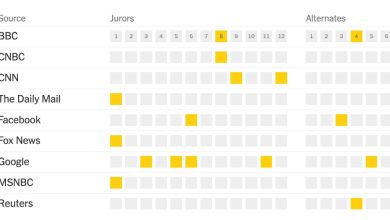Hamas Attack Raises Questions Over an Israeli Intelligence Failure

The devastating surprise attack by Hamas on Saturday represented an equally stunning intelligence failure by Israel that involved undetected warnings, overwhelmed missile defenses and a slow response by apparently unprepared military forces, former and current U.S. officials said.
American officials said Hamas had achieved a complete tactical surprise, reflected in a death toll of at least 700 Israelis. The Palestinian militant group sent hundreds of fighters through breached walls, breaking through with bulldozers and then killing civilians and soldiers in shooting sprees that went on for hours.
None of Israel’s intelligence services had specific warning that Hamas was preparing a sophisticated attack that required coordinated land, air and sea strikes, according to an Israeli defense official and American officials. While the attack also surprised many Western intelligence agencies, they do not track Hamas’s activities as closely as Israel or Egypt do.
The success astounded American officials with experience in the region. Over the years, Israel has set up a network of electronic intercepts, sensors and human informants throughout Gaza, which is about half the area of New York’s five boroughs. Israel and its neighbors have in the past invested heavily in trying to track and block Hamas’s networks, often intercepting shipments of missile components.
That past success has made all the more urgent a series of questions about Israel’s failures on Saturday.
Why was Israel’s Iron Dome missile defense system, now a dozen years old, apparently overwhelmed by the barrage of inexpensive but deadly missiles at the opening of the attack? How did Hamas manage to build such a big arsenal of rockets and missiles without Israeli intelligence detecting the growing stockpile?
Was Israel too focused on threats from Hezbollah and the West Bank, rather than focusing military and intelligence resources on Gaza? And why were so many Israeli forces on leave or distant from the southern border, allowing Hamas to overrun Israeli military bases near Gaza?
Neither American nor Israeli officials would address the questions on Sunday. But clearly the answers could affect the reputation of Israel’s military and intelligence agencies, and the political future of Prime Minister Benjamin Netanyahu.
“Hamas has challenged the very fundamental concept of Israeli deterrence,” said Kenneth F. McKenzie Jr., a retired Marine Corps general and former top American commander in the Middle East. “It can only be re-established with the application of overwhelming, shocking violence. And it is only getting started.”
But as Mr. Netanyahu’s government retaliates, and deals with the reality that Hamas has taken scores of Israeli hostages, the question of what went wrong will go down in history alongside other such failures. The most famous one in Israeli history was 50 years ago this week, during the Yom Kippur War. Others likened the surprise to the Tet offensive of the Vietnam War or even the Sept. 11, 2001, attacks.
Past rocket barrages by Hamas have been blunted in part by Israel’s missile defense system, known as the Iron Dome. But on Saturday the system appeared overwhelmed. Hamas was able to fire hundreds of missiles in rapid succession, potentially more than the system’s interceptors could handle. The Iron Dome is designed to protect population centers and does not shoot if it determines an incoming missile or rocket will land harmlessly. But it has a limited number of Tamir interceptors, and reloading the system can take time. Hamas, one former administration official said, appeared to have studied the system’s vulnerabilities.
But the system has dealt effectively with large barrages before, former officials said, suggesting that new weapons fired by Hamas for the first time Saturday could be harder to intercept and may have also played a role.Hamas used a new missile system known as Rajum during the attack, and also employed small drones that dropped munitions on Israeli military positions, according to Janes, a defense and open-source intelligence firm.
On Saturday, Hamas fired a wide variety of rocket and missile systems, both the new ones and older models. But almost all of its rockets and missiles are Iranian-designed weapons that are smuggled into Gaza as components then assembled covertly.
Both Israel and Egypt try to monitor efforts to smuggle components, many originally from Iran, through the Sinai Peninsula and into Gaza through underground tunnels, according to former U.S. intelligence officials. In 2021, Israel reported destroying 62 miles of underground tunnels, and built underground barriers 65 yards deep. Egypt has also worked to seal tunnels between Gaza and the peninsula.
But no barrier is perfect. And, in addition to underground and sea routes, missile and rocket components are smuggled through the legal crossings, the former officials said.
Israel has typically used extensive human networks in Gaza and intercepts of electronic communications to generate warnings of potential attacks, according to former American officials. The fact that Israeli intelligence was caught off-guard by the strikes suggests that before Saturday’s attacks, Hamas fighters avoided discussing the plans over mobile phones or other means of communications that could be intercepted.
Hamas likely used old-school face-to-face planning to avoid Israeli detection. But hundreds of people must have been involved, demonstrating that Hamas’s efforts to break Israel’s network of informants has been successful, according to the former officials.
Though it is shocking that Israel missed the preparations for the attack, said Beth Sanner, a former senior American intelligence official, she added that few spy agencies are as good at learning from their mistakes as Israel’s.
“Because intelligence collection is a human endeavor, failure is inevitable,” she said. “Unfortunately it has happened at the most consequential time, when they are facing the most consequential threat in a half a century.”
In retrospect, some believe the Israelis made erroneous assumptions about the nature of the threat from Hamas. “What people don’t understand is that while Hamas was treated as a terrorist organization, there were decisions made by Israel to make life easier for Gazans,” said Thomas Nides, the former American ambassador to Israel, who left Jerusalem this summer. “They issued 15,000 work permits, for workers in Gaza who came into Israel each day, and I believe there was a view that Hamas would not screw that up.”
“Which clearly was wrong,” Mr. Nides added.
Gaza has been under an Israeli blockade, backed by Egypt, since Hamas seized control of the coastal strip in 2007. The blockade restricts the import of goods, including electronic and computer equipment, that could be used to make weapons and prevents most people from leaving the territory. Tensions between Israelis and Palestinians have also been surging for months, as have warnings of the risk of all-out war.
Most of the recent focus has been on the occupied West Bank, where recurring Israeli military operations have sparked frequent gun battles with Palestinian militants. Israel and Palestinian militants in the Gaza Strip have also fought smaller tit-for-tat engagements.
And American intelligence officials were clearly worried that trouble was brewing.
This spring, William J. Burns, the director of the Central Intelligence Agency, warned that tensions between Israelis and Palestinians were threatening to bubble over again, despite the diplomatic progress in the region.
But Israel appeared more focused on the West Bank as a potential source of an attack, rather than Gaza.
Experts cautioned that there was still much to learn about what precisely Israeli intelligence knew, and what warning signs were missed. And the same question can be asked about Egypt and other Arab governments that have no love for Hamas, and often quietly share intelligence with Israel.
“While overall this is an intelligence failure, just how and in what way remains to be seen,” said Lewis Smart, the lead Middle East analyst with Janes, the defense intelligence firm.
A key question American intelligence agencies were wrestling with over the weekend was the involvement of Iran in supplying Hamas and encouraging or even planning the attack. It is plausible that Iran could have played a role, American officials said, but that exact role is not yet clear.
For Iran, its alliance with Hamas is a key point of leverage. Tehran, according to current and former officials, wants to derail the emerging peace between Saudi Arabia and Israel. Any war between Israel and Hamas that causes significant civilian casualties on both sides would make any such public peace incredibly difficult.
“You have to ask yourself who benefits from this,” said General McKenzie. “Well Iran does because it pushes a wedge between Israel and the Saudis.”




